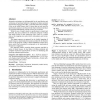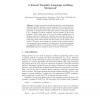1826 search results - page 60 / 366 » Using Random Forests in the Structured Language Model |
ECEASST
2008
13 years 8 months ago
2008
: Model transformations play a significant role in model based software development, and the correctness of the transformation is crucial to the success of the development effort. ...
IEE
2008
13 years 8 months ago
2008
ion techniques are indispensable for the specification and verification of functional behavior of programs. In object-oriented ation languages like JML, a powerful abstraction tec...
PAMI
2008
13 years 8 months ago
2008
We address the issue of classifying complex data. We focus on three main sources of complexity, namely, the high dimensionality of the observed data, the dependencies between these...
FM
2006
Springer
14 years 11 days ago
2006
Springer
Design patterns are usually described in terms of instances. Templates describe sentences of some language with a particular form, generate sentences upon instantiation, and can be...
EMNLP
2009
13 years 6 months ago
2009
This paper describes an empirical study of high-performance dependency parsers based on a semi-supervised learning approach. We describe an extension of semisupervised structured ...


